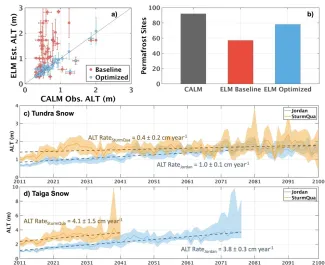We improved land surface model simulations of active layer thickness across more than 100 permafrost sites over the pan-Arctic domain by optimizing model snow- and peat soil-related schemes.
Thawing permafrost can release large amounts of greenhouse gases, exacerbating global warming. Permafrost stability is influenced by the thermal buffering of snow and organic peat soils with low thermal conductivity, and inaccurate representation of these processes in models can lead to overestimations in the thickness of the thawed soil active layer (active layer thickness, ALT) above permafrost. Here, we used the Energy, Exascale Earth System Model (E3SM) Land Model (ELM) to simulate permafrost dynamics at more than 100 sites from the Circumpolar Active Layer Monitoring (CALM) network. We examined the effects of precipitation-phase (rain or snow) partitioning methods, snow compaction schemes, snow thermal conductivity schemes, and organic matter content throughout the soil profile on simulated soil temperature and ALT. We compared these simulations with CALM measurements, and significantly improved ELM-simulated site-level ALT by optimizing snow-related schemes and the characteristics of organic (peat) soil used in the model. Our sensitivity analysis revealed that both snow-related schemes and peat soil organic matter density profiles significantly impacted simulated soil temperature and ALT. Notably, we predicted that taiga sites would transition to a permafrost-free state earlier than predicted by other model schemes, highlighting the importance of accurately representing snow and soil thermal properties to enhance permafrost simulations.
Citation: Tao J, Riley WJ, Zhu Q. 2024. Evaluating the impact of peat soils and snow schemes on simulated active layer thickness at pan-Arctic permafrost sites. Environmental Research Letters 19: 054027. https://doi.org/10.1088/1748-9326/ad38ce
Contact and email address: Jing Tao (jingtao@lbl.gov)


